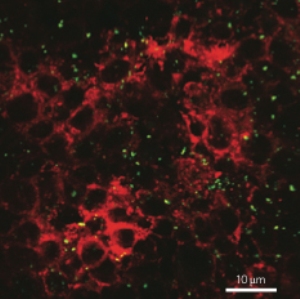Researchers from the Cornell University have studied the iron absorption in chicken after intake of nanoparticles. The effects of FDA-approved polystyrene nanoparticles, which have been used in numerous food substances ranging from vitamins to food additives, have been studied.
 "An intestinal cell monolayer after exposure to nanoparticles, shown in green."
"An intestinal cell monolayer after exposure to nanoparticles, shown in green."
The research team conducted the study in both in vivo and in vitro conditions. Both chronic and acute exposure to nanoparticles was examined in human intestinal cells taken in Petri plates and live chicken.
Dr. Gretchen Mahler from Cornell University illustrated that chickens were selected for the study due to their similarities with humans in iron absorption and sensitivity to deficiencies of micronutrient.
The polystyrene carboxylated nanoparticles of size 50nm, which are available commercially and believed to be safe for humans, were used in the study. In acute exposure for a few minutes to hours, the iron absorption slipped down in both in vivo and in vitro conditions, whereas in chronic exposure at the rate of about 2mg/kg for a period of two weeks (), an increase in the iron absorption was observed. This increase was due to structural changes in the villi leading to an increase in its surface area.
Dr. Mahler stated that this physiological remodeling was not anticipated. Michael Shuler, who led this research, on a positive note, said that the remodeling shows the ability of the body to adapt to changes. However, he was worried that the alteration may cause increased absorption of other unsafe compounds too.
Numerous engineered nanoparticles are consumed by humans everyday in the form of pharmaceuticals and food. This research cautions humans about the health hazards of nanoparticle consumption.